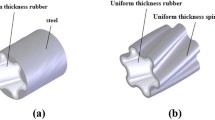Abstract
In order to meet the high temperature environment requirement of deep and superdeep well exploitation, a technology of large length-to-diameter ratio metal stator screw lining meshing with rotor is presented. Based on the elastic-plasticity theory, and under the consideration of the effect of tube size, material mechanical parameters, friction coefficient and loading paths, the external pressure plastic forming mechanical model of metal stator screw lining is established, to study the optimal loading path of metal stator lining tube hydroforming process. The results show that wall thickness reduction of the external pressure tube hydroforming (THF) is about 4%, and three evaluation criteria of metal stator screw lining forming quality are presented: fillet stick mold coefficient, thickness relative error and forming quality coefficient. The smaller the three criteria are, the better the forming quality is. Each indicator has a trend of increase with the loading rate reducing, and the adjustment laws of die arc transition zone equidistance profile curve are acquired for improving tube forming quality. Hence, the research results prove the feasibility of external pressure THF used for processing high-accuracy large length-to-diameter ratio metal stator screw lining, and provide theoretical basis for designing new kind of stator structure which has better performance and longer service life.
Similar content being viewed by others
References
HU Jian-yi, WU Yin-ye, ZHANG Jing. Discussion on petroleum geology theory for high-elevation and ultra-deep formations [J]. Acta Petrolei Sinica, 2009, 30(2): 159–167. (in Chinese)
ZHU Xiao-hua, SHI Chang-shuai, TONG Hua. Influence of static press, pressure difference and Poisson’s ratio on deformation of stator lining [J]. Journal of Southwest Petroleum University, 2010, 32(6): 175–179. (in Chinese)
ZHU Xiao-hua, JIA Yan-jie, TONG Hua. Critical weight on bit of double-driven bottom hole assembly during vertical and fast drilling [J]. Journal of Central South University, 2012, 19(2): 572–577.
LI Shu-hui, YANG Bing, ZHANG Wei-gang, LIN Zhong-qin. Loading path prediction for tube hydroforming process using a fuzzy control strategy [J]. Materials and Design, 2008, 29: 1110–1116.
CRAPPS J, MARIN E B, HORSTEMEYER M F, YASSAR R, WANG P T. Internal state variable plasticity-damage modeling of the copper tee-shaped tube hydroforming process [J]. Journal of Materials Processing Technology, 2010, 210: 1726–1737.
FIORENTINO A, CERETTI E, BRAGA D, MARZI R. Friction in asymmetric feeding tube hydroforming [J]. International Journal of Material Forming, 2010, 3(1): 275–278.
LI Shu-hui, CHEN Xian-feng, KONG Qing-shuai, YU Zhong-qi, LIN Zhong-qin. Study on formability of tube hydroforming through elliptial die inserts [J]. Journal of Materials Processing Technology, 2012, 212: 1916–1924.
PAUNOIU V, CIOCANIOCAN O, NICOARA D. Numerical study of tube hydroforming technology [J]. International Journal of Modern Manufacturing Technologies, 2010, 2(1): 67–72.
LIU Xiao-jing, YAN Wei, DAI Hong-qing. Effect of hydraulic pressure loading paths on forming of automobile panels based on numerical simulation [J]. Journal of Central South University (Science and Technology), 2008, 39(3): 543–548. (in Chinese)
PRASAD VARMA N S, NARASIMHAN R, LUO A A, SACHDEV A K. An analysis of localized necking in aluminium alloy tubes during hydroforming using a continuum damage model [J]. International Journal of Mechanical Sciences, 2007, 49: 200–209.
SADAKATSU F. Recent development in tube hydroforming technology in Japan [J]. Journal of Plasticity Engineering, 2007, 14(5): 171–179.
CHEBBAH M S, NACEUR H, GAKWAYA A. A fast algorithm for strain prediction in tube hydroforming based on one-step inverse approach [J]. Journal of Materials Processing Technology, 2011, 211: 1898–1906.
SEYEDKASHI S M H, NAEINI H M, LIAGHAT G H, MASHADI M M, MIRZAALI M, SHOJAEE K, MOON Y H. The effect of tube dimension on optimized pressure and force loading paths in tube hydroforming process [J]. Journal of Mechanical Science and Technology, 2012, 26: 1817–1822.
SIEGERTK. Research in hydroforming at the institute of metal forming technology of the University of Stuttgart [J]. Hydroforming of Tubes, Extrusions and Sheet Metals, 2003, 3: 245–258.
DAI Jun-tao. Determining of contact friction and friction coefficient of metal pressure processing [J]. Forging & Stamping Technology, 1984(5): 48–54. (in Chinese)
MARIELA L, BIBIANA M L. Numerical simulation of the lubricant performance in tube hydroforming [J]. Journal of Materials Processing Technology, 2008, 198(1/2/3): 372–380.
SUN Yan-yan. Research on variable cross section tube hydroforming process [D]. Shenyang: Shenyang University, 2008. (in Chinese)
Author information
Authors and Affiliations
Corresponding author
Additional information
Foundation item: Project(51222406) supported by the National Natural Science Foundation of China; Project(NCET-12-1061) supported by the Funds for New Century Excellent Talents in University of China; Project(12TD007) supported by the Scientific Research Innovation Team Program of Sichuan Colleges and Universities, China; Project(2014TD0025) supported by the Youth Scientific Research Innovation Team Program of Sichuan Province, China
Rights and permissions
About this article
Cite this article
Zhu, Xh., Shi, Cs. & Tong, H. Optimizing loading path and die linetype of large length-to-diameter ratio metal stator screw lining hydroforming. J. Cent. South Univ. 22, 224–231 (2015). https://doi.org/10.1007/s11771-015-2513-y
Received:
Accepted:
Published:
Issue Date:
DOI: https://doi.org/10.1007/s11771-015-2513-y




